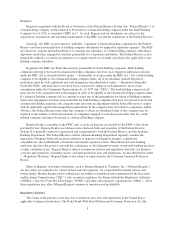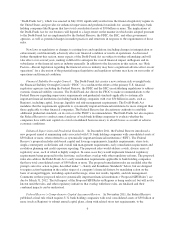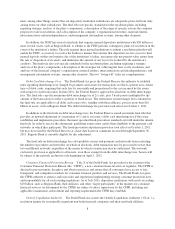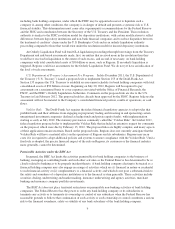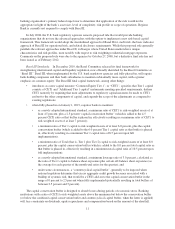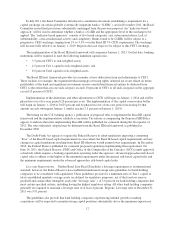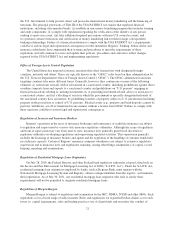Regions Bank 2011 Annual Report Download - page 36
Download and view the complete annual report
Please find page 36 of the 2011 Regions Bank annual report below. You can navigate through the pages in the report by either clicking on the pages listed below, or by using the keyword search tool below to find specific information within the annual report.In July 2011, the Basel Committee introduced a consultative document establishing a requirement for a
capital surcharge on certain globally systemically important banks (“G-SIBs”), and in November 2011, the Basel
Committee issued final provisions substantially unchanged from the previous proposal. An “indicator-based
approach” will be used to determine whether a bank is a G-SIB and the appropriate level of the surcharge to be
applied. The “indicator-based approach” consists of five broad categories: size, interconnectedness, lack of
substitutability, cross-jurisdictional activity and complexity. Banks found to be G-SIBs will be subject to a
progressive CET1 surcharge ranging from 1% to 3.5% over the Basel III 7% CET1 requirement. The surcharge
will become fully effective on January 1, 2019. Regions does not expect to be subject to this CET1 surcharge.
The implementation of the Basel III final framework will commence January 1, 2013. On that date, banking
institutions will be required to meet the following minimum capital ratios:
• 3.5 percent CET1 to risk-weighted assets;
• 4.5 percent Tier 1 capital to risk-weighted assets; and
• 8.0 percent Total capital to risk-weighted assets.
The Basel III final framework provides for a number of new deductions from and adjustments to CET1.
These include, for example, the requirement that mortgage servicing rights, deferred tax assets reliant on future
profitability of the bank and significant investments in non-consolidated financial entities be deducted from
CET1 to the extent that any one such category exceeds 10 percent of CET1 or all such categories in the aggregate
exceed 15 percent of CET1.
Implementation of the deductions and other adjustments to CET1 will begin on January 1, 2014 and will be
phased-in over a five-year period (20 percent per year). The implementation of the capital conservation buffer
will begin on January 1, 2016 at 0.625 percent and be phased in over a four-year period (increasing by that
amount on each subsequent January 1, until it reaches 2.5 percent on January 1, 2019).
The timing for the U.S. banking agency’s publication of proposed rules to implement the Basel III capital
framework and the implementation schedule is uncertain. The release accompanying the Proposed SIFI Rules
appears to indicate that rules implementing Basel III will be published for comment during the first quarter of
2012. The rules ultimately adopted may be different from the Basel III final framework as published in
December 2010.
The Dodd-Frank Act appears to require the Federal Reserve to adopt regulations imposing a continuing
“floor” of the Basel I-based capital requirements in cases where the Basel II-based capital requirements and any
changes in capital regulations resulting from Basel III otherwise would permit lower requirements. In December
2010, the Federal Reserve published for comment proposed regulations implementing this requirement. On
June 14, 2011, the Federal Reserve, FDIC and Office of the Comptroller of the Currency (OCC) jointly approved
a final rule which requires a banking organization operating under the agencies’ advanced approaches risk-based
capital rules to adhere to the higher of the minimum requirements under the general risk-based capital rules and
the minimum requirements under the advanced approaches risk-based capital rules.
Leverage Requirements. Neither Basel I nor Basel II includes a leverage requirement as an international
standard; however, the Federal Reserve has established minimum leverage ratio guidelines for bank holding
companies to be considered well-capitalized. These guidelines provide for a minimum ratio of Tier 1 capital to
total consolidated quarterly average assets (as defined for regulatory purposes), net of the loan loss reserve,
goodwill and certain other intangible assets (the “leverage ratio”), of 3.0 percent for bank holding companies that
meet certain specified criteria, including having the highest regulatory rating. All other bank holding companies
generally are required to maintain a leverage ratio of at least 4 percent. Regions’ Leverage ratio at December 31,
2011 was 9.91 percent.
The guidelines also provide that bank holding companies experiencing internal growth or making
acquisitions will be expected to maintain strong capital positions substantially above the minimum supervisory
12





